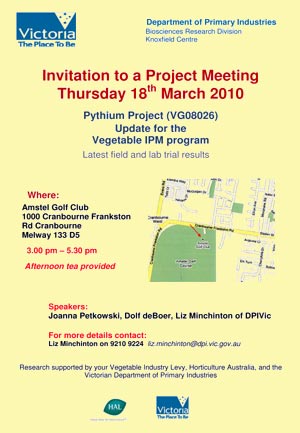|
Pythiums have been described as the “common cold” of plants. They are ubiquitous in the vegetable industry and their damage goes unnoticed unless extreme, such as damping off of seedlings and cavity spot of carrots.
Pythiums are fast growing and rapidly reproduce. They attack root hairs and lateral roots impairing water and nutrient uptake thus reducing productivity in the early stages of crop production.
This nationally focused three-year project will establish IPM strategies in Victoria and confirm their efficacy interstate.
The project aims to determine :
- the role of Pythiums in disease complexes (in field, hydroponics and laboratory studies)
- factors that favor Pythium damage (soil moisture, nutrients and temperature in field and growth chamber studies)
- the efficacy of biological, cultural and chemical controls and benchmark the economics of control options.
This project update was presented to a workshop meeting of vegetable growers and agronomists at Cranbourne, Victoria in March 2010.
Authors
|
|
Liz Minchinton
|
Dolf deBoer
|
|
Joanna Petkowski
|
Len Tesoriero
|
|
Peter DalSanto
|
|


Conclusions:
- Control of canker with metalaxyl in the sandy soil supports the view that Pythium species are important in the development of canker.
- The fact that metalaxyl did not control the disease on clay soil may be due to enhanced degradation of this chemical in the soil.
- Metalaxyl degradation has been reported to occur in slightly alkaline soils under anaerobic conditions.
- Clay soils may require other options for disease management such as aeration and improved structure using appropriate rotation crops e.g. plants with deep root systems.
Monthly surveys of pathogen genera at trial sites at Clyde and Devon Meadows :
- This study confirms the view that Pythium species are involved in the development of canker on parsnip roots, perhaps by providing a means of entry of other pathogens or saprophytes.
Testing the pathogenicity of different fungi to parsnip :
- F. oxysporium proved to be the most pathogenic of the fungi tested on parsnip roots, but produced relatively small lesions. Similar symptoms have been observed in the field.
- Pythium sulcatum was not particularly pathogenic on the mature parsnip roots.
- This experiment will be repeated on parsnip seedlings to determine whether infection by Pythium depends on the age of the plant.
Efficacy of biological control agents for Pythia in hydroponic Coriander crops :
- A number of Pythium species proved to be very damaging to Coriander grown in a hydroponics system.
- Bacillus subtilis showed promise in controlling root rot of Coriander.
- However, this treatment may need to be applied regularly throughout the growing season to provide effective protection against root rot.
Acknowledgments :
Funding was provided by Australian vegetable growers (through the R & D levy) and the Department of Primary Industries, Victoria. The Australian Government provides matched funding for all HAL’s R&D activities.
|

